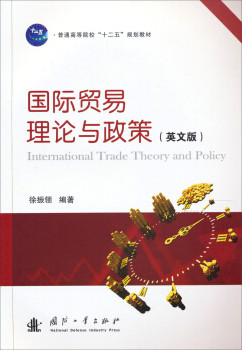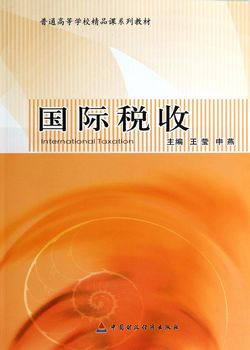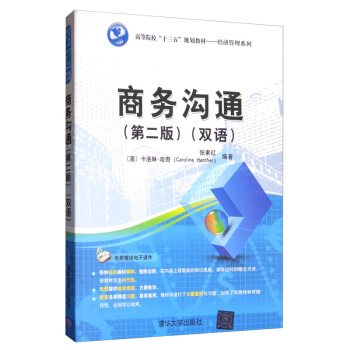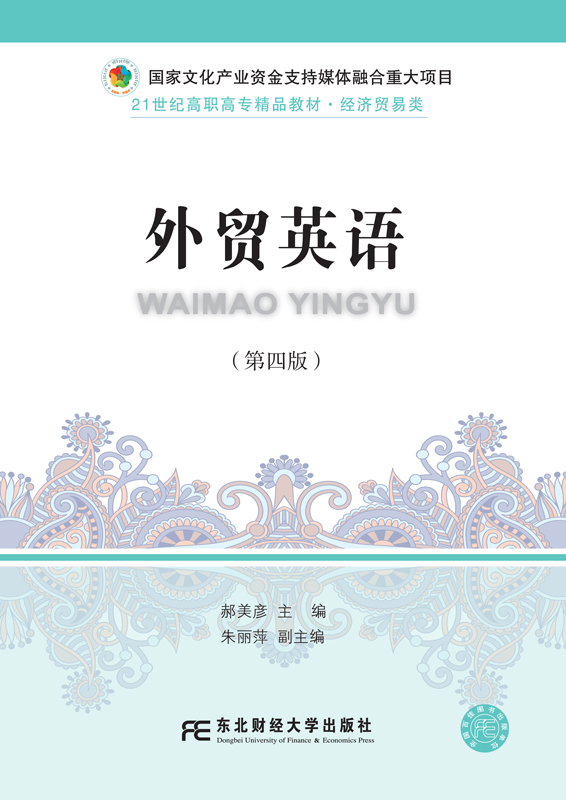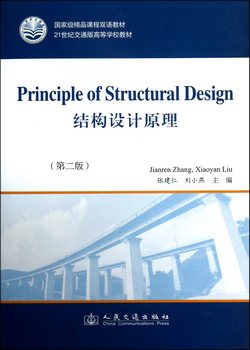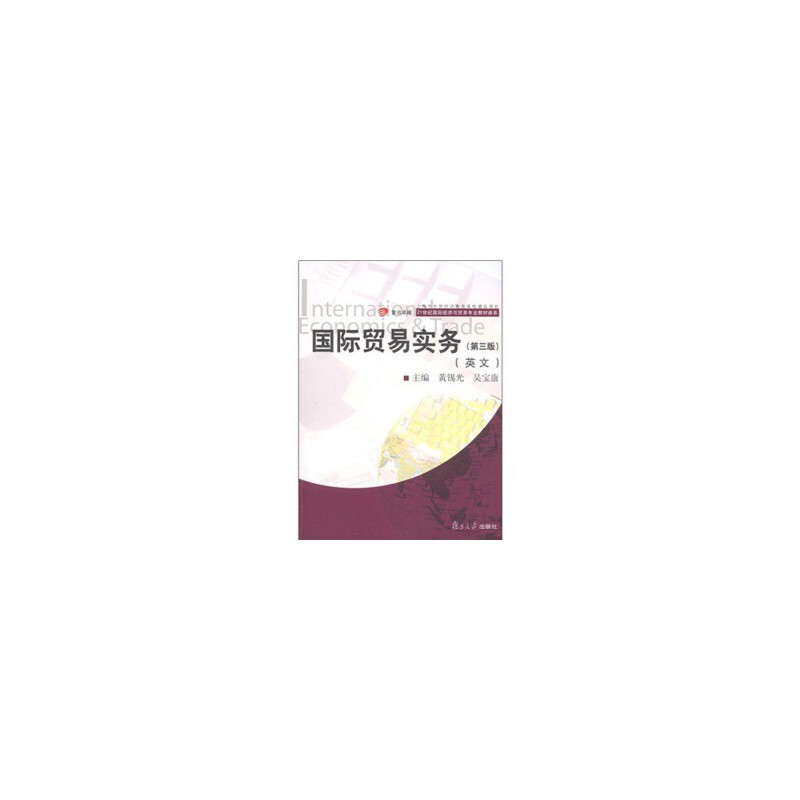国际贸易理论与政策(英文版) / 普通高等院校“十二五”规划教材
¥48.00定价
作者: 徐振领,徐振领
出版时间:2013-06
出版社:国防工业出版社
- 国防工业出版社
- 9787118087833
- 1
- 174923
- 平装
- 16开
- 2013-06
- 526
- 355
内容简介
《普通高等院校“十二五”规划教材:国际贸易理论与政策(英文版)》分为五个部分,共13章。全书主要围绕国际贸易理论与政策两个方面展开,理论部分重点阐述了传统贸易理论(包括古典和新古典贸易理论)和新贸易理论,同时解释了商品生产地理集中和生产过程的国际化分工。政策部分重点阐述了关税理论和世界贸易组织对中国出具的贸易政策审议报告中提及的非关税措施.以及应急贸易措施。不管是理论部分还是政策部分,教材均引用了诸多与中国相关的数据和案例。
《普通高等院校“十二五”规划教材:国际贸易理论与政策(英文版)》的读者对象主要为高等院校国际贸易类专业本科及部分英文基础较好的专科学生。
《普通高等院校“十二五”规划教材:国际贸易理论与政策(英文版)》也可以作为国际贸易从业人员的参考学习材料。
《普通高等院校“十二五”规划教材:国际贸易理论与政策(英文版)》的读者对象主要为高等院校国际贸易类专业本科及部分英文基础较好的专科学生。
《普通高等院校“十二五”规划教材:国际贸易理论与政策(英文版)》也可以作为国际贸易从业人员的参考学习材料。
目录
Part I Introduction
Chapter 1 History of International Trade
1.1 Trade in Ancient Ages: to the 1th Century BC
1.1.1 The market place
1.1.2 Waterborne traffice: 3000 - 1000 BC
1.1.3 The caravan: from 1000 BC
1.1.4 A trade route from China: 2nd century BC
1.2 Trade in Middle Ages: to the 15th Century AD
1.2.1 World trade: from the 1tt Century AD
1.2.2 The troding kingdoms of West Afriea: 5th- 15thc. AD
1.2.3 Vikings in Russia: from the 9th century AD
1.2.4 The Pax Mongoliea and the Silk Rood: 13th-14th Century AD
1.2.5 Hanseatic League: 12th - 17th Century AD
1.2.6 Ups and downs in the economy: 12th - 14th Century AD
1.2.7 The Portuguese slave trade: 15ts - 17th Century AD
1.2.8 Chinese sea trade: 15th Century
1.3 Trade in Modem Ages: Since 16th Century AD
1.3.1 Early Modem Ages
1.3.2 Later Modem Ages
1.3.3 Post War
Chapter 2 Basic Concepts of International Trade
2.1 International Trade and Foreign Trade
2.2 Value of Trade and Quantum of Trade
2.2.1 Value of Trade
2.2.2 Quantum of Trade
2.3 The Commodity Composition of Trade
2.4 Geographical Composition of Trade
2.5 Dependence Degree of Foreign Trade
2.6 Balance of Trade
2.7 Terms of Trade
Chapter 3 Basic Classifications of International Trade
3.1 Export Trade, hnport Trade and Transit Trade
3.2 Direct Trade, Indirect Trade and Entrepot Trade
3.3 Trade System : General Trade System and Special Trade System
3.4 Visible trade and invisible trade
Part Ⅱ The Causes of Trade
Chapter 4 Traditional Trade Theory : Gains from Specialization
4.1 Comparative Advantage Theory: Differences in Technogy
4.1.1 Mercantilism
4.1.2 Adam Smith's Theory of Absolute Advantage
4.1.3 The Theory of Comparative Advantage
4.1.4 Microeconomie Analysis of Comparative Advantage
4.2 H-O Theory : Differences in resource endowments
4.2.1 The Heckseher-Ohlin Theory
4.2.2 The Standard Heckseher -Ohlin Model
4.2.3 Empirical Tests of the Heckscher-Ohlin Theory
4.3 Intermediate inputs, services, tasks and fragmentation
4.3.1 Intermediate inputs and comparative advantage
4.3.2 Trade in services and comparative advantage
4.3.3 Trade in tasks, fragmentation and comparative of advantage
Chapter 5 New Trade Theory
5.1 Intra-industry Trade
5.2 Imperfect Competition and Trade
5.2.1 Monopolistic Competition
5.2.2 Reciprocal Dumping
Part Ⅲ Trade, The Location of Production and The Industrial Organization of Firms
Chapter 6 Falling International Trade Costs
6.1 Tariff and Non-tariff Costs
6.2 Transport Costs
6.3 Costs of Connecting People
Chapter 7 Geographical Concentration
7.1 New Economic Geography
7.2 Home Market and Magnification Effects
7.3 Agglomeration Effects
7.4 Core-periphery Effects
Chapter 8 International Fragmentation of Production
8.1 Offshoring of Goods and Services
8.1.1 Expansion of Offshoring Goods and Services
8.1.2 The Most Offshoring Countries and Seetoral Composition of Offshoring
8.2 The economics of International Organization of Production
8.2.1 The decision to offshore
8.2.2 Offshoring: arm's-length transactions or vertical FDI
8.2.3 Barriers hindering entry to international production networks
Part IV International Trade Poeliey
Chapter 9 Tariffs
9.1 An Introduction to Tariffs
9.2 Effects of Tariff
9.2.1 Microeconoralc Analytical Instruments
9.2.2 The Effects of a Tariff
9.2.3 The Theory of Tariff Structure
Chapter 10 Non-Tariff Measures
10.1 Preshipment Inspection
10.2 Customs Valuation
10.3 Rules of Origin
10.4 Licensing
10.5 State Trading Enterprises
10.6 Government Procurement
10.7 Standards and Other Technical Requirements
10.8 Export PromotiOns
Chapter 11 Contingency Trade Measures
11.1 Anti-dumping
11.2 Subsidies and Countervailing Measures
11.3 Safeguard Measures
Part V Trade Agreements and Arrangements
Chapter 12 GATT and WTO
12.1 The GAIT years: from Havana to Marrakesh
12.2 The Uruguay Round
12.3 Principles of the trading system
12.4 The WTO Organization
12.5 A Navigational Guide to the Agreements
12.6 Setting Disputes
12.6.1 A unique contribution
12.6.2 The Panel Process
19.6.3 Case study: the timetable in practice
Chapter 13 Regional Economic Integration
13.1 Introduction to Regional Economic Integration
13.2 The Static and Dynamic Effects of Economic Integration
13.3 Integration in Europe
13.4 Regional Trade Arrangements of China
Bibliography
Chapter 1 History of International Trade
1.1 Trade in Ancient Ages: to the 1th Century BC
1.1.1 The market place
1.1.2 Waterborne traffice: 3000 - 1000 BC
1.1.3 The caravan: from 1000 BC
1.1.4 A trade route from China: 2nd century BC
1.2 Trade in Middle Ages: to the 15th Century AD
1.2.1 World trade: from the 1tt Century AD
1.2.2 The troding kingdoms of West Afriea: 5th- 15thc. AD
1.2.3 Vikings in Russia: from the 9th century AD
1.2.4 The Pax Mongoliea and the Silk Rood: 13th-14th Century AD
1.2.5 Hanseatic League: 12th - 17th Century AD
1.2.6 Ups and downs in the economy: 12th - 14th Century AD
1.2.7 The Portuguese slave trade: 15ts - 17th Century AD
1.2.8 Chinese sea trade: 15th Century
1.3 Trade in Modem Ages: Since 16th Century AD
1.3.1 Early Modem Ages
1.3.2 Later Modem Ages
1.3.3 Post War
Chapter 2 Basic Concepts of International Trade
2.1 International Trade and Foreign Trade
2.2 Value of Trade and Quantum of Trade
2.2.1 Value of Trade
2.2.2 Quantum of Trade
2.3 The Commodity Composition of Trade
2.4 Geographical Composition of Trade
2.5 Dependence Degree of Foreign Trade
2.6 Balance of Trade
2.7 Terms of Trade
Chapter 3 Basic Classifications of International Trade
3.1 Export Trade, hnport Trade and Transit Trade
3.2 Direct Trade, Indirect Trade and Entrepot Trade
3.3 Trade System : General Trade System and Special Trade System
3.4 Visible trade and invisible trade
Part Ⅱ The Causes of Trade
Chapter 4 Traditional Trade Theory : Gains from Specialization
4.1 Comparative Advantage Theory: Differences in Technogy
4.1.1 Mercantilism
4.1.2 Adam Smith's Theory of Absolute Advantage
4.1.3 The Theory of Comparative Advantage
4.1.4 Microeconomie Analysis of Comparative Advantage
4.2 H-O Theory : Differences in resource endowments
4.2.1 The Heckseher-Ohlin Theory
4.2.2 The Standard Heckseher -Ohlin Model
4.2.3 Empirical Tests of the Heckscher-Ohlin Theory
4.3 Intermediate inputs, services, tasks and fragmentation
4.3.1 Intermediate inputs and comparative advantage
4.3.2 Trade in services and comparative advantage
4.3.3 Trade in tasks, fragmentation and comparative of advantage
Chapter 5 New Trade Theory
5.1 Intra-industry Trade
5.2 Imperfect Competition and Trade
5.2.1 Monopolistic Competition
5.2.2 Reciprocal Dumping
Part Ⅲ Trade, The Location of Production and The Industrial Organization of Firms
Chapter 6 Falling International Trade Costs
6.1 Tariff and Non-tariff Costs
6.2 Transport Costs
6.3 Costs of Connecting People
Chapter 7 Geographical Concentration
7.1 New Economic Geography
7.2 Home Market and Magnification Effects
7.3 Agglomeration Effects
7.4 Core-periphery Effects
Chapter 8 International Fragmentation of Production
8.1 Offshoring of Goods and Services
8.1.1 Expansion of Offshoring Goods and Services
8.1.2 The Most Offshoring Countries and Seetoral Composition of Offshoring
8.2 The economics of International Organization of Production
8.2.1 The decision to offshore
8.2.2 Offshoring: arm's-length transactions or vertical FDI
8.2.3 Barriers hindering entry to international production networks
Part IV International Trade Poeliey
Chapter 9 Tariffs
9.1 An Introduction to Tariffs
9.2 Effects of Tariff
9.2.1 Microeconoralc Analytical Instruments
9.2.2 The Effects of a Tariff
9.2.3 The Theory of Tariff Structure
Chapter 10 Non-Tariff Measures
10.1 Preshipment Inspection
10.2 Customs Valuation
10.3 Rules of Origin
10.4 Licensing
10.5 State Trading Enterprises
10.6 Government Procurement
10.7 Standards and Other Technical Requirements
10.8 Export PromotiOns
Chapter 11 Contingency Trade Measures
11.1 Anti-dumping
11.2 Subsidies and Countervailing Measures
11.3 Safeguard Measures
Part V Trade Agreements and Arrangements
Chapter 12 GATT and WTO
12.1 The GAIT years: from Havana to Marrakesh
12.2 The Uruguay Round
12.3 Principles of the trading system
12.4 The WTO Organization
12.5 A Navigational Guide to the Agreements
12.6 Setting Disputes
12.6.1 A unique contribution
12.6.2 The Panel Process
19.6.3 Case study: the timetable in practice
Chapter 13 Regional Economic Integration
13.1 Introduction to Regional Economic Integration
13.2 The Static and Dynamic Effects of Economic Integration
13.3 Integration in Europe
13.4 Regional Trade Arrangements of China
Bibliography

